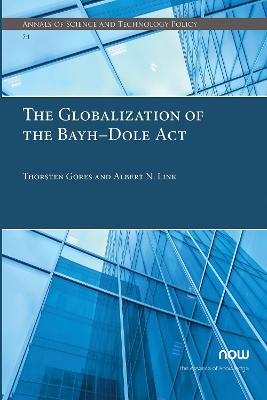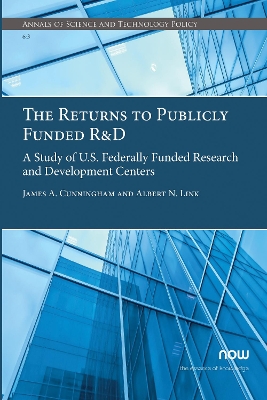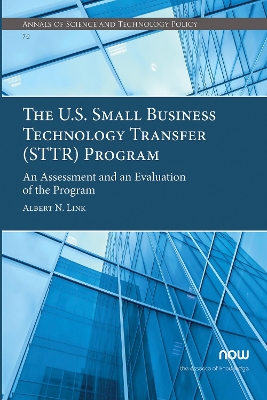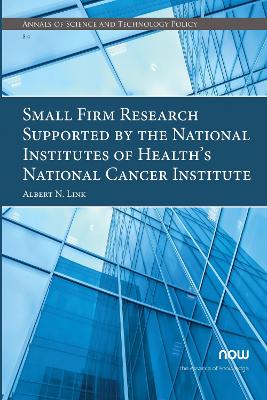Annals of Science and Technology Policy
6 total works
Public Support of Private Innovation
by John W. Hardin, David J. Kaiser, and Albert N. Link
Published 10 June 2020
Public Support of Private Innovation describes the One North Carolina Small Business Program's purpose and history, as well as offer an assessment of whether it has met its stated goals and objectives. Through an analysis of data collected through a 2017 survey of all the program's grantee companies, this monograph provides both descriptive findings as well as econometric assessments of the Program against its four stated goals. Both the descriptive findings and the econometric analyses are supportive of the conclusion that the program is meeting its legislatively authorized purpose and goals.
This monograph is divided into five sections. Section 1 provides background context on the One North Carolina Small Business Program. Section 2 describes the Federal SBIR and STTR Programs and how North Carolina has fared under the programs since their establishment. Section 3 presents descriptive information on the programs' survey and sets the stage for section 4, which details the econometric assessment of the program. Concluding observations are presented in section 5.
This monograph is divided into five sections. Section 1 provides background context on the One North Carolina Small Business Program. Section 2 describes the Federal SBIR and STTR Programs and how North Carolina has fared under the programs since their establishment. Section 3 presents descriptive information on the programs' survey and sets the stage for section 4, which details the econometric assessment of the program. Concluding observations are presented in section 5.
Provides a nontechnical reference source of the relevant social science and policy literature on nanotechnology. The authors hope to engender not only a greater appreciation of the economic and social benefits of nanotechnology but also to encourage more extensive research and public support of this technology.
Section 2 briefly overviews U.S. policy initiatives related to nanotechnology and to the systematic investment in research that the U.S. Congress has approved to advance it over the nearly past two decades. Section 3 summarizes these U.S. research investments into nanotechnology and compares dimensions of nanotechnology activity in the United States to activity in other countries. Section 4 offers a taxonomy and overview of the relevant social science and policy literature related to nanotechnology. The taxonomy is a subjective classifying device for tracking the growth of this literature over time; the overview is a descriptive summary of how researchers in these disciplines have characterized the practice of nanotechnology.
The appendix to this monograph presents an annotated bibliography of this literature. The extensive annotated bibliography fills a gap in the literature because the reviews that exist are limited in scope, and the review points out the lack of policy research related to public investments in nanotechnology. Finally, Section 5 suggests specific directions for future policy research with a focus on a methodology for evaluating the social benefits of publicly funded nanotechnology R&D investments.
Section 2 briefly overviews U.S. policy initiatives related to nanotechnology and to the systematic investment in research that the U.S. Congress has approved to advance it over the nearly past two decades. Section 3 summarizes these U.S. research investments into nanotechnology and compares dimensions of nanotechnology activity in the United States to activity in other countries. Section 4 offers a taxonomy and overview of the relevant social science and policy literature related to nanotechnology. The taxonomy is a subjective classifying device for tracking the growth of this literature over time; the overview is a descriptive summary of how researchers in these disciplines have characterized the practice of nanotechnology.
The appendix to this monograph presents an annotated bibliography of this literature. The extensive annotated bibliography fills a gap in the literature because the reviews that exist are limited in scope, and the review points out the lack of policy research related to public investments in nanotechnology. Finally, Section 5 suggests specific directions for future policy research with a focus on a methodology for evaluating the social benefits of publicly funded nanotechnology R&D investments.
The Globalization of the Bayh–Dole Act
by Thorsten Gores and Albert N. Link
Published 4 January 2021
The Globalization of the Bayh-Dole Act examines an overlooked metric associated with the impact of the Bayh-Dole Act, namely its effect on influencing university-based technology transfer policies in other countries. To substantiate this thesis, Bayh-Dole like university technology transfer policies in 20 other countries are reviewed. In an effort toward an assessment of these Bayh-Dole like policies, the monograph explores in each country higher education expenditures on research and development (R&D) before and after the Bayh-Dole like policies were adopted. The authors conclude that, in terms of this metric, in some countries the Bayh-Dole like policies have been more effective than in others.
The Returns to Publicly Funded R&D focuses on the returns to U.S. public-sector investments in R&D and the accompanying new empirical analysis relates specifically to the returns to public-sector R&D expenditures in U.S. Federally Funded Research and Development Centers (FFRDCs). One motivation for studying the rates of return to public-sector R&D is the paucity of existing literature on the topic. However, there are two other important motivations for studying the rates of returns to public-sector R&D: a public accountability motivation and a mandated public policy motivation. Although the analysis of investments in R&D in FFRDCs presented herein is econometrics based, there is however a frequently overlooked program evaluation literature that also offers insight into the rates of returns to public-sector R&D. Examples of the program evaluation literature is presented in Section 3 for completeness as well as to illustrate a broader rate of return concept than that presented in the econometrics-based literature. U.S. legislative actions to increase publicly funded R&D in support of private-sector R&D are discussed in Section 4. For the purpose of providing context, a brief history of FFRDCs in the United States is presented in Section 5. FFRDCs have surprisingly been an overlooked element of the public-sector ecosystem that supports public-sector research. An empirical analysis of U.S. public-sector R&D expenditures in FFRDCs, and the associated scientific publications, is presented and discussed in Section 6. Concluding observations about the themes discussed throughout this monograph are offered in Section 7.
The U.S. Small Business Technology Transfer (STTR) Program: An Assessment and an Evaluation of the Program is intended to expand the National Academies’ report and set a stage for more in depth studies in the future of the STTR program by offering a systematic analytical overview of the STTR program and tying that overview to a qualitative/quantitative assessment and evaluation of the program given the limited data collected by and available from the NRC. In addition, this is an effort to orientate readers to a number of nuances of the STTR program that were beyond the scope of the National Academies’ report. A secondary purpose is to highlight the economic importance of the STTR program itself.
The remainder of this monograph is organized as follows. The legislative background for the STTR program is discussed in Section 2. Section 3 explains program assessments and program evaluations from a conceptual perspective. Section 4 describes the nature of the NRC’s dataset used in this study, and based on that dataset a systematic analytical overview of the STTR program is presented. Section 5 presents a qualitative/quantitative assessment of the STTR program followed by a qualitative/quantitative evaluation of the STTR program in Section 6. Section 7 offers a summary of the paper and some concluding observations and additional suggestions for future NRC-led studies.
The remainder of this monograph is organized as follows. The legislative background for the STTR program is discussed in Section 2. Section 3 explains program assessments and program evaluations from a conceptual perspective. Section 4 describes the nature of the NRC’s dataset used in this study, and based on that dataset a systematic analytical overview of the STTR program is presented. Section 5 presents a qualitative/quantitative assessment of the STTR program followed by a qualitative/quantitative evaluation of the STTR program in Section 6. Section 7 offers a summary of the paper and some concluding observations and additional suggestions for future NRC-led studies.
Small Firm Research Supported by the National Institutes of Health’s National Cancer Institute
by Albert N. Link
Published 30 October 2024
Small Firm Research Supported by the National Institutes of Health’s National Cancer Institute focuses on and describes dimensions of research and innovative behavior in a unique sample of small firms publicly funded through the Small Business Innovation Research (SBIR) program and discusses the policy implications from the descriptive findings. Section 2 briefly overviews the history of the National Institutes of Health (NIH) and its oldest Institute, the National Cancer Institute (NCI). Section 3 offers a roadmap for the study of small firm research funded through the NCI’s SBIR program. Section 4 describes the data used to explore dimensions of small firm SBIR funded research. The findings from the empirical analysis of the data described in Section 4 that are related to the commercialization of NCI-funded new technologies are presented in Section 5.
The findings from the empirical analysis of the data described in Section 4 that are related to the outflow of technical knowledge through technology transfer metrics from NCI-funded new technologies are described in Section 6. Technology relationships are the focus of Section 7. Section 8 explores the dimensions of funded firms that responded on the NRC survey that they would have pursued their Phase II project in the absence of SBIR funding. Section 9 considers the social impact of the NCI as quantified through the producer surplus and consumer surplus generated from the sale of NCI funded research projects. Section 10 concludes with a discussion of the findings from the analyses related to the NCI’s support of small firm research and offers a call for future studies that address this topic from the perspective of other NIH Institutes and Centers and from the perspective of U.S. research agencies in general.
The findings from the empirical analysis of the data described in Section 4 that are related to the outflow of technical knowledge through technology transfer metrics from NCI-funded new technologies are described in Section 6. Technology relationships are the focus of Section 7. Section 8 explores the dimensions of funded firms that responded on the NRC survey that they would have pursued their Phase II project in the absence of SBIR funding. Section 9 considers the social impact of the NCI as quantified through the producer surplus and consumer surplus generated from the sale of NCI funded research projects. Section 10 concludes with a discussion of the findings from the analyses related to the NCI’s support of small firm research and offers a call for future studies that address this topic from the perspective of other NIH Institutes and Centers and from the perspective of U.S. research agencies in general.





